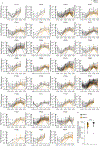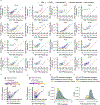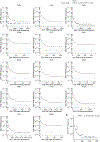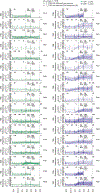Repeated mRNA vaccination sequentially boosts SARS-CoV-2-specific CD8+ T cells in persons with previous COVID-19
- PMID: 38057617
- PMCID: PMC10981451
- DOI: 10.1038/s41590-023-01692-x
Repeated mRNA vaccination sequentially boosts SARS-CoV-2-specific CD8+ T cells in persons with previous COVID-19
Abstract
Severe acute respiratory syndrome coronavirus 2 (SARS-CoV-2) hybrid immunity is more protective than vaccination or previous infection alone. To investigate the kinetics of spike-reactive T (TS) cells from SARS-CoV-2 infection through messenger RNA vaccination in persons with hybrid immunity, we identified the T cell receptor (TCR) sequences of thousands of index TS cells and tracked their frequency in bulk TCRβ repertoires sampled longitudinally from the peripheral blood of persons who had recovered from coronavirus disease 2019 (COVID-19). Vaccinations led to large expansions in memory TS cell clonotypes, most of which were CD8+ T cells, while also eliciting diverse TS cell clonotypes not observed before vaccination. TCR sequence similarity clustering identified public CD8+ and CD4+ TCR motifs associated with spike (S) specificity. Synthesis of longitudinal bulk ex vivo single-chain TCRβ repertoires and paired-chain TCRɑβ sequences from droplet sequencing of TS cells provides a roadmap for the rapid assessment of T cell responses to vaccines and emerging pathogens.
© 2023. Springer Nature America, Inc.
Conflict of interest statement
Conflict of Interest Statements:
HSR and RE are employees of Adaptive Biotechnologies, Inc. B.E., E.E. and M.R.H. performed this work as employees of Laulima Government Solutions. M.M. and E.P. are subcontractors to Laulima Government Solutions; they performed this work as employees of Tunnell Government Services. The other authors have no competing interest. The funders had no role in study design, data collection and analysis, decision to publish or preparation of the manuscript.
Figures














References
MeSH terms
Substances
Grants and funding
- K08 AI148588/AI/NIAID NIH HHS/United States
- R01 AI134878/AI/NIAID NIH HHS/United States
- 75N93019C00063/AI/NIAID NIH HHS/United States
- S10 OD028685/OD/NIH HHS/United States
- S10 AI174104/AI/NIAID NIH HHS/United States
- UM1 AI068614/AI/NIAID NIH HHS/United States
- P01 CA225517/CA/NCI NIH HHS/United States
- F30 CA254168/CA/NCI NIH HHS/United States
- HHSN272201800013C/AI/NIAID NIH HHS/United States
- R01 AI136514/AI/NIAID NIH HHS/United States
- R21 AI163999/AI/NIAID NIH HHS/United States
- T32 CA080416/CA/NCI NIH HHS/United States
LinkOut - more resources
Full Text Sources
Medical
Research Materials
Miscellaneous

